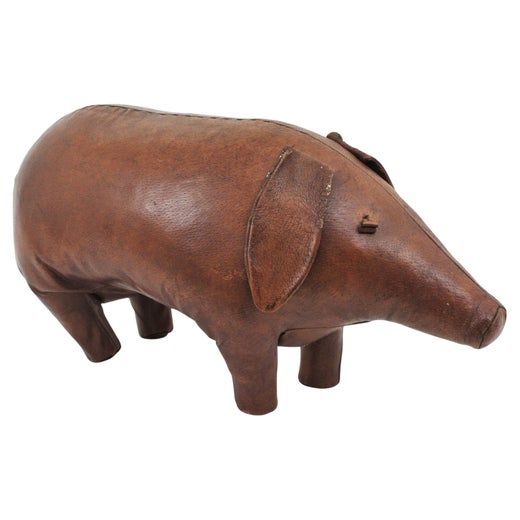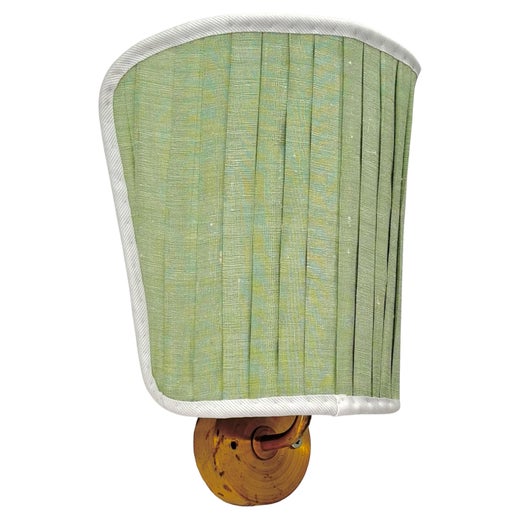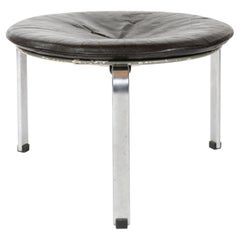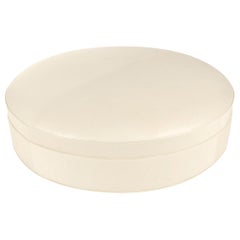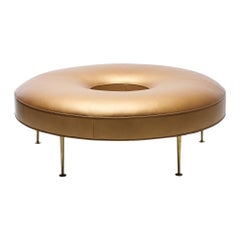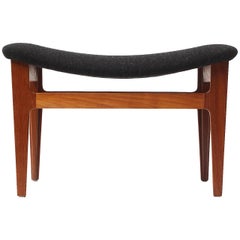Black Leather Pig Ottoman
About the Item
- Creator:Dimitri Omersa (Designer),Svenskt Tenn (Manufacturer)
- Dimensions:Height: 15 in (38.1 cm)Width: 32 in (81.28 cm)Depth: 11 in (27.94 cm)
- Style:Scandinavian Modern (Of the Period)
- Materials and Techniques:
- Place of Origin:
- Period:
- Date of Manufacture:1950
- Condition:Wear consistent with age and use.
- Seller Location:Sagaponack, NY
- Reference Number:Seller: 7979.0021stDibs: LU89031063446
Dimitri Omersa
Omersa is best known for its iconic leather footstools and decorative objects that take on animal forms. The British furniture brand appropriately began with a pig.
Legend has it that a man named “Old Bill” worked for eclectic department store Liberty of London and wanted to use leftover scraps of leather from handmade luggage to craft an animal-shaped footstool. The first swine-shaped ottoman was born in 1927. Decades later, in 1958, Yugoslavian native Dimitri Omersa had found work in the leather industry in a town in Hertfordshire after time spent imprisoned in the years following World War II. He was working for an independent leather company when he and Bill crossed paths. Taking a shine to one another, Dimitri took over production of the playful leather pig footstools and ottomans for Liberty, and Old Bill retired.
Omersa’s line of animal-themed furnishings expanded to include donkeys, elephants and more. The company made these home accessories in the United Kingdom specifically for Liberty until the mid-1970s and the ears of the lovable leather creatures that were produced during the era are said to have been adorned with the retailer’s branding. A leather badge now appears on the furnishings that is inclusive of the name Omersa as well as the year of manufacture.
Today Omersa creates bespoke leather stools, desktop accessories and other seating in various animal shapes. The company’s artisans rely on traditional methods to craft each of their pieces by hand, paying particular attention to sustainable practices. To this day, Liberty continues to stock the Omersa animals it has carried since the 1930s.
In 1963, the animals crossed the pond to America and won a gold medal at the California State Fair. The mid-1960s saw a relationship take shape between Omersa and Abercrombie & Fitch — long before it transformed into a clothing mecca for teens in the 1990s and early 2000s — while the 1980s saw Omersa forge a partnership with Scully and Scully, a purveyor of luxury furniture and decor founded in New York City.
Dimitri Omersa passed away in 1975, but the animals continued to be produced by his wife Inge for another decade.
While the ownership of the business has changed hands more than once since then, Omersa’s artisans continue to create a range of animal-shaped decorative objects and furnishings that include sheep, cows, horses and more. Annual production is limited, and each piece, made with top grain cowhide leather sourced from an environmentally responsible UK tannery and stuffed with the wood wool of European pine trees, is designed and produced by local craftspersons in Lincolnshire, England.
Find authentic Dimitri Omersa leather animals, decorative objects, seating and other furniture on 1stDibs.
Svenskt Tenn
Today, the name Svenskt Tenn is associated around the world with the vibrant, modernist textiles and furniture of Josef Frank, who was the Swedish company’s chief designer in the mid-20th century. But the term “svenskt tenn” actually means “Swedish pewter,” and the very first goods the company sold were stylish pewter objects, such as an elegant 1927 candelabra found in the collection of the Saint Louis Art Museum, or a sleek, understated mirror in the collection of the National Museum of Fine Arts. These pieces were designed to appeal to discerning but price-conscious shoppers in 1920s-era Stockholm.
Art teacher and interior designer Estrid Ericson (1894–1981) partnered with pewter artisan Nils Fougstedt (1881–1954) to establish Svenskt Tenn in 1924, and their creations quickly gained a reputation for high quality and affordability, winning a gold medal at the International Exhibition of Modern Decorative and Industrial Arts in Paris in 1925 — the design fair that brought global attention to the Art Deco style.
The experience of renovating her own apartment in the 1920s exposed Ericson to Swedish functionalism — or funkis, as it was known in Sweden — a branch of modernism that advocated uncomplicated forms, subdued colors and utility. She was inspired to open an interior design department at Svenskt Tenn, and in 1930 the firm introduced its first line of furniture.
Selections included items produced by the companies Gemla and Bodafors, as well as original designs by Ericson and the architects Uno Åhrén and Björn Trägårdh, who had worked together on the redesign and expansion of the showroom. The trio’s furniture was displayed at Stockholm’s Galleri Modern in 1931, where it was met with praise from critic Gotthard Johansson, a leading proponent of Swedish functionalism. Johansson admired the “pure lines” and “modern austerity” of the furniture, establishing Svenskt Tenn as an important voice in Swedish design.
But the signature partnership that would come to define the look of Svenskt Tenn was in part the result of political turmoil and the emergence of Nazism in Europe. When Josef Frank fled Vienna for Stockholm in 1933, he was already an accomplished architect who questioned modernist orthodoxy in design. He disliked tubular steel furniture and believed that monochromatic surfaces were distressing to viewers, while pattern and ornament gave interiors a sense of warmth and calm. Ericson was an admirer of Frank’s work, and offered him the chance to design products for Svenskt Tenn. Their professional partnership, particularly in textile design, would eventually become one of the hallmarks of Swedish modernism.
Frank and Ericson collaborated from 1934 until Frank’s death in 1967, with Frank creating unmistakable, bold designs and Ericson employing her flair for interiors, merchandising and display. The pair called their shared approach “Accidentism” or “The Happy Chances Philosophy,” mixing and matching the new and antique, the serious with the playful and pattern with solid colors to find eclectic new combinations in their showroom.
Frank’s textiles are like a visual catalogue of exotic plants and flowers, geological formations and maps, inspired in part by Ericson’s world travels and by Frank’s love of folk art. Svenskt Tenn continues to sell fabric, wallpaper and household goods, many of which sport variations of Frank's signature botanical motifs. Antique and vintage Svenskt Tenn pewter, lighting, furniture, textiles and decorative objects are generally priced anywhere from $2,500 to $25,000 depending on scale and condition.
The tenets of Scandinavian modernism are as fresh and relevant now as they were in the 1950s — light-filled and airy rooms with white walls are perfect settings for comfortable furniture upholstered in one of Josef Frank’s indelible patterns, and nearly a century since its founding, the signature aesthetic of Svenskt Tenn remains as distinctive and timeless as ever.
Find antique and vintage Svenskt Tenn mirrors, seating, tables and other furniture on 1stDibs.
You May Also Like
Vintage 1960s Austrian Mid-Century Modern Stools
Chrome
21st Century and Contemporary Asian American Classical Ottomans and Poufs
Leather, Canvas
Vintage 1950s Great Britain (UK) Ottomans and Poufs
Leather
Late 20th Century French Hollywood Regency Stools
Metal
Late 20th Century Italian Modern Ottomans and Poufs
Leather
Vintage 1960s American Ottomans and Poufs
Brass
21st Century and Contemporary Portuguese Neoclassical Ottomans and Poufs
Leather
20th Century American Adirondack Stools
Leather, Wood
2010s German Modern Ottomans and Poufs
Upholstery, Bentwood, Leather, Lacquer
Vintage 1950s French Ottomans and Poufs
Leather
More From This Seller
View AllVintage 1950s Danish Scandinavian Modern Stools
Chrome
2010s American Mid-Century Modern Ottomans and Poufs
Leather
21st Century and Contemporary American Ottomans and Poufs
Upholstery
Vintage 1950s Danish Scandinavian Modern Ottomans and Poufs
Teak, Upholstery
2010s American Ottomans and Poufs
20th Century Danish Ottomans and Poufs
Wood
